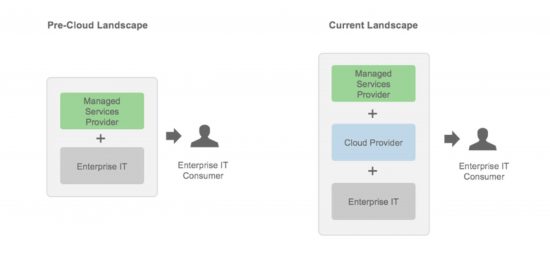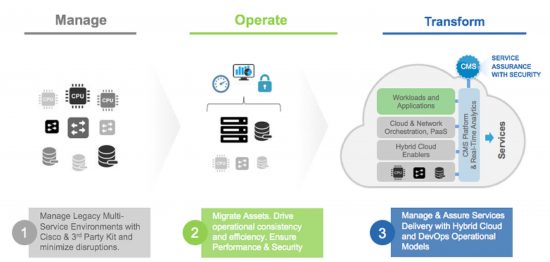Defining Managed Services and Cloud Computing
Managed Services is traditionally understood to be the practice of having a third party Service Provider – also known as a Managed Services Provider (MSP), take over the IT operations management (ITOM) responsibilities and functions from an enterprise’s internal IT. The third-party aspect is highlighted in the use of the prefix “out” as a part of words like “out-sourcing” or “out-tasking” that are used to describe this practice. Companies typically look at leveraging MSPs to help achieve their strategic business goals of improving operational efficiencies, managing complexity and driving new technology adoption.
On the other hand, Cloud Computing enables organizations to consume compute resources as a utility, rather than having to build and maintain computing infrastructures in-house. Three key benefits of Cloud Computing to businesses are that the computing resources are abstracted, managed and made consumable such that they are:
- Self-provisionable and available on-demand
- Elastic i.e. can be scaled up or down based on demand
- Pay-For-Use i.e. resources usage can be metered granularly and users can be charged for exact usage
It is also well understood by now that Cloud Computing can be classified as Private or Public – the difference being whether the entity managing and providing the Cloud Computing resources is internal or external to the company.

In both Managed Services and Cloud Computing – regardless of whether it is Private or Public, there is a third-party entity that is providing a service to the consuming business entity. The fact that the services being provided in both cases are generally in the realm of computing and IT operations management, in my opinion causes some people to draw false equivalency. This then leads to thoughts where organizations ponder if Managed Services is even relevant in the context of Cloud Computing.
How Managed Services will evolve in a Cloud Computing world
Thoughts about whether Managed Services will be relevant to Cloud Computing were more rampant during the earlier days of Cloud. These days, the real question is not whether Managed Services is relevant in the context of Cloud Computing, but rather, how Managed Services will evolve to meet the demands of customers in a Cloud Computing centric landscape. After all, Managed Services is a business that has continually evolved over the years in response to dynamic market demands – from the early days of break-fix for PCs, through the era of networking and the Internet, to current service management models predicated on proactive and predictive management methods.
Here are a few points worth remembering about the applicability and relevance of Managed Services to Cloud Computing.
- Managed Services is no longer about just keeping the lights on
Traditionally, Managed Services has been about keeping the lights on. This is why Managed Services started out with addressing IT break-fix, and ultimately evolved to the proactive IT operations management it offers today. With Cloud Computing, the responsibility of keeping the lights on is now the job of the Cloud Services Provider. Instead, Managed Services will now become about helping organizations understand how to effectively and optimally use the various capabilities made possible by Cloud Computing. The focus also shifts broadly to the application, and away from infrastructure management. This changes the way IT departments have to organize themselves, and MSPs can be the key to helping lead the change.
- Complexity drives demand for Managed Services and Cloud Computing ain’t that simple
One of the key attributes of Cloud Computing as an operational model is that it makes self service possible. People sometimes make the mistake of extrapolating the simplicity of self service to management. This leads to a sentiment that Cloud makes management simpler and that organizations should now be able to handle management themselves. This is of course not true. In fact, with the proliferation of technology options in a Cloud Computing world, complexity is at an all-time high. Just ask the average IT staffer to navigate and make sense of the AWS or Google Cloud console. It is not that simple. It is no wonder that Amazon themselves have a growing list of Managed Services partners listed on their web site.
- Hybrid, Multi-Vendor IT is here to stay. There is even more stuff to manage now!
The vast majority of enterprises will likely adopt and implement a Hybrid IT approach for the foreseeable approach that includes some combination of private and public clouds with traditional on-premises IT that is, invariably, multi-vendor. Consequently, the demand for Managed Services that cover all the elements of Hybrid, Multi-Vendor IT will continue to be in demand. MSPs can be invaluable in helping internal IT teams manage legacy IT, bridge their current gaps of knowledge wrt Cloud and then help transform to a Cloud operational model.
- The need for Specialized Domain Expertise and Seasonality become a part of the equation
With everything moving to, or being organized in, a Cloud operating model (e.g. databases, applications, and analytics), there is a need for specialized management expertise in each of those areas. Let us take big data for example. It requires specialized expertise not only in terms of infrastructure implementation and operations but also to process and draw analytical value out of all of the data. For many organizations, this specialized and varied expertise is not readily sourced or economically justifiable – especially since seasonality could affect demand for this expertise over the year.
- Compliance and Security concerns are now compounded
Cloud Computing is only compounding the compliance and security concerns that CIOs traditionally rate as one of their top concerns. This is evidenced in virtually every industry and analyst poll taken on the subject. Staying on top of evolving requirements in the areas of compliance and security in a Cloud world can be a challenge for IT departments that are already stretched thin. MSPs can really help organizations stay on top of their compliance and security policies as the IT landscape evolves to include the Cloud, thus enabling their IT departments to focus precious resources and energies on more strategic initiatives for the company.
Managed Services for IaaS, PaaS and even SaaS
Now that we have established the relevance and the need for Managed Services in the Cloud Computing context, let us look at how Managed Services could be applied broadly to the three models of Cloud Computing, i.e. Infrastructure-as-a-Service (IaaS), Platform-as-a-Service (PaaS) and Software-as-a-Service (SaaS).

IaaS
Private or Public IaaS Cloud providers such as Amazon Web Services enable the provisioning and consumption of one or more virtual server instances along with requisite storage. The lifecycle management of these instances (e.g. configure, start, stop, scale etc.) is done via a web console or through application programming interfaces (APIs).
Public IaaS cloud providers often provide a rich set of features and capabilities that vary by provider, and that can be overwhelming to the uninitiated. Understanding the proper way to interface with these capabilities, and effectively manage and orchestrate workloads in the context of a Hybrid, Multi-Vendor IT environment can be challenging. Virtual Machine proliferation is also an issue. The costs of running forgotten VMs can add up. Monitoring and managing the lifecycle of the VMs is a full time challenge. MSPs can help immensely by bringing their deep operational expertise across the various technologies, in addition to helping enforce policies around accounting, compliance and security.
PaaS
In the PaaS model, Cloud providers are responsible for hosting development tools and environments that developers can consume over the Internet using APIs, Web portals and gateways. PaaS can be delivered on-premises as part of a Private Cloud solution, or directly across the Internet by a Public Cloud provider.
In the case of a Private Cloud, the operational management of the underlying infrastructure to prevent latency and ensure availability, performance, policy compliance and security present plenty of opportunities for Managed Services. Even in the case of an organization consuming a public PaaS, Managed Services can help provide organizations with valuable expertise to enforce policies around accounting, compliance and security, wrapped around the other Hybrid IT services that are also likely in use by the organization.
SaaS
SaaS refers to the cloud model that delivers software applications that are consumed over the web via a browser or a mobile device. For example, Microsoft Office 365 is a SaaS offering for productivity software and email services.
It may be believed that given the simplicity of SaaS, management is a non-issue. However, with the growing popularity of SaaS it is likely that most organizations are consuming more than one SaaS offer across their entities. In the most likely case, where these multiple SaaS offers come from different providers, organizations end up having to deal with multiple activation and on-boarding processes. User provisioning & lifecycle management, orchestration, SLA management, policy enforcement, compliance and security across the different SaaS offers is non-trivial. Here again MSPs can be provide value by helping IT to create, provide and enforce a common user experience and operating model across all the SaaS offers.
How Cisco Cloud & Managed Services can help
It should be clear by now that Managed Services is evolving and will be even more relevant with the growing management complexity resulting from the adoption and proliferation of Hybrid Cloud Computing and multi-vendor IT environments. The ability of an organization’s IT function to handle this increased demand for services will continue to be a challenge, especially amid the backdrop of growing complexity and limited resources, budgets and expertise.

The Cisco Hybrid Cloud Product Portfolio is comprehensive and provides all the building blocks for putting together a cutting edge Hybrid Cloud infrastructure comprising Infrastructure (e.g UCS, Nexus, Hyperflex), Orchestration & Management (e.g. UCS-Director, ACI, Cisco Cloud Center/CliQr) and PaaS (Cisco Cloud Native Development Platform).
Cisco Cloud and Managed Services (CMS) wraps managed services around the Cisco portfolio as well as around third party solutions. In combination with Cisco’s product expertise, CMS is uniquely positioned to help organizations looking for a MSP who can not only manage their existing heterogeneous, multi-vendor IT infrastructure, but also be a partner and trusted advisor in helping them transform their IT into a Hybrid Cloud operating model. CMS can truly be your bridge to the Hybrid Cloud.
For an in-depth look at why you should care about Managed Services, read our Managed Services Solution Overview, and visit us on Cisco.com.
CONNECT WITH US